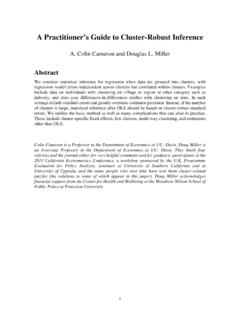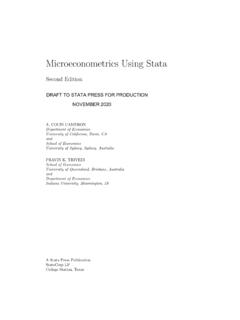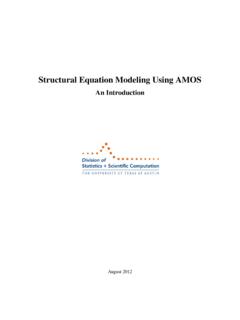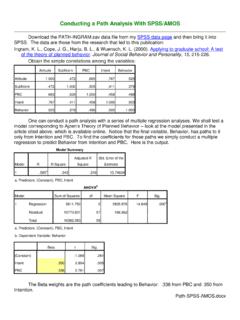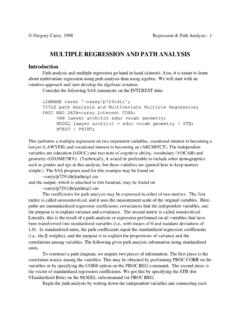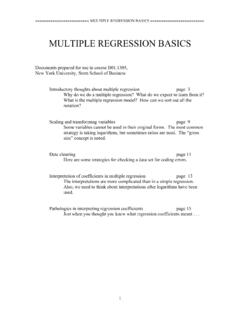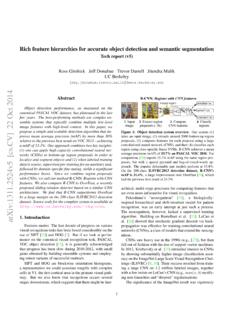Transcription of 4.8 Instrumental Variables
1 Instrumental Instrumental VariablesA major complication that is emphasized in microeconometrics is the possibility ofinconsistent parameter estimation due to endogenous regressors. Then regressionestimates measure only the magnitude of association, rather than the magnitudeand direction of causation which is needed for policy Instrumental Variables estimator provides a way to nonetheless obtain con-sistent parameter estimates. This method, widely used in econometrics and rarelyused elsewhere, is conceptually dif cult and easily provide a lengthy expository treatment that de nes an Instrumental variableand explains how the Instrumental Variables method works in a simple Inconsistency of OLSC onsider the scalar regression model with dependent variableyand single regres-sorx.
2 The goal of regression analysis is to estimate the conditional mean functionE[yjx]. A linear conditional mean model, without intercept for notational conve-nience, speci esE[yjx] = x:( )This model without intercept nests the model with intercept if dependent and re-gressor Variables are measured as deviations from their respective means. Interestlies in obtaining a consistent estimate of as this gives the change in the con-ditional mean given anexogenouschange inx. For example, interest may lie inthe effect in earnings due to an increase in schooling due to exogenous reasons,such as an increase in the minimum school leaving age, that are not a choice of OLS regression model speci esy= x+u;( )whereuis an error term.
3 regression ofyonxyields OLS estimateb of .Standard regression results make the assumption that the regressors are uncor-related with the errors in the model ( ). Then the only effect ofxonyis a directeffect via the term x. We have the following path analysis diagramx !y%uwhere there is no association 4. LINEAR MODELSBut in some situations there may be an association between regressors anderrors. For example, consider regression of earnings(y)on years of schooling(x).The error termuembodies all factors other than schooling that determine earnings,such as ability. Suppose a person has a high level ofu, due to high (unobserved)ability.
4 This increases earnings, sincey= x+u. But it may also lead to higherlevels ofx, since schooling is likely to be higher for those with high ability. Amore appropriate path diagram is then the followingx !y" %uwhere now there is an association are the consequences of this correlation betweenxandu? Now higherlevels ofxhave two effects ony. From ( ) there is both a direct effect via xand an indirect effect viaueffectingxwhich in turn effectsy. The goal ofregression is to estimate only the rst effect, yielding an estimate of . The OLSestimate will instead combine these two effects, givingb > in this examplewhere both effects are positive.
5 Using calculus, we havey= x+u(x)with totalderivativedydx= +dudx:( )The data give information ondy=dx, so OLS estimates the total effect +du=dxrather than alone. The OLS estimator is therefore biased and inconsistent for ,unless there is no association more formal treatment of the linear regression model withKregressors leadsto the same conclusion. From subsection a necessary condition for consistencyof OLS is thatplimN 1X0u=0. Consistency requires that the regressors areasymptotically uncorrelated with the errors. From ( ) the magnitude of theinconsistency of OLS is(X0X) 1X0u, the OLS coef cient from regression ofuonx.
6 This is just the OLS estimate ofdu=dx, con rming the intuitive result in( ). Instrumental VariableThe inconsistency of OLS is due to endogeneity ofx, meaning that changes inxare associated not only with changes inybut also changes in the erroru. What isneeded is a method to generate only exogenous variation inx. An obvious way isthrough an experiment, but for most economics applications experiments are tooexpensive or even Instrumental VARIABLES37De nition of an InstrumentA crude experimental or treatment approach is still possible using observationaldata, provided there exists aninstrumentzthat has the property that changes inzare associated with changes inxbut do not led to change iny(aside from theindirect route viax).
7 This leads to the following path diagramz !x !y" %uwhich introduces a variablezthat is associated withxbut notu. It is still the casethatzandywill be correlated, but the only source of such correlation is the indirectpath ofzbeing correlated withxwhich in turn determinesy. The more direct pathofzbeing a regressor in the model foryis ruled formally, a variablezis called aninstrumentorinstrumental variablefor the regressorxin the scalar regression modely= x+uif (1)zis uncorrelatedwith the erroru;and (2)zis correlated with the rst assumption excludes the instrumentzfrom being a regressor in themodel fory, since if insteadydepended on bothxandzandyis regressed onxalone thenzis being absorbed into the error so thatzwill then be correlated withthe error.
8 The second assumption requires that there is some association betweenthe instrument and the variable being of an InstrumentIn many microeconometric applications it is dif cult to nd legitimate we provide two we want to estimate the response of market demand to exogenouschanges in market price. Quantity demanded clearly depends on price, but pricesare not exogenously given since they are determined in part by market demand. Asuitable instrument for price is a variable that is correlated with price but does notdirectly effect quantity demanded. An obvious candidate is a variable that effectsmarket supply, since this also effect prices, but is not a direct determinant of de-mand.
9 An example is a measure of favorable growing conditions if an agriculturalproduct is being modelled. The choice of instrument here is uncontroversial, pro-vided favorable growing conditions do not directly effect demand, and is helpedgreatly by the formal economic model of supply and suppose we want to estimate the returns to exogenous changes in school-ing. Most observational data sets lack measures of individual ability, so regressionof earnings on schooling has error that includes unobserved ability and hence is38 CHAPTER 4. LINEAR MODELS correlated with the regressor schooling. We need an instrumentzthat is correlatedwith schooling, uncorrelated with ability and more generally is uncorrelated withthe error term which means that it cannot directly determine popular candidate forzis proximity to college or university (Card, 1995).
10 This clearly satis es condition 2 as, for example, people whose home is a longway from a community college or state university are less likely to attend most likely satis es 1, though since it can be argued that people who live a longway from a college are more likely to be in low-wage labor markets one needs toestimate a multiple regression forythat includes as additional regressors controlssuch as indicators for non-metropolitan second candidate for the instrument is month of birth (Angrist and Krueger,1991). This clearly satis es condition 1 as there is no reason to believe that monthof birth has a direct effect on earnings if the regression includes age in years.
